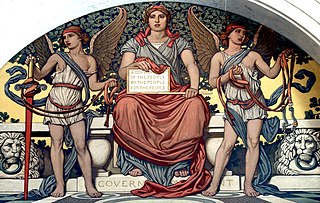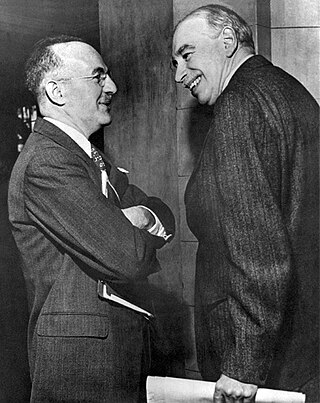Related Research Articles
The General Agreement on Tariffs and Trade (GATT) is a legal agreement between many countries, whose overall purpose was to promote international trade by reducing or eliminating trade barriers such as tariffs or quotas. According to its preamble, its purpose was the "substantial reduction of tariffs and other trade barriers and the elimination of preferences, on a reciprocal and mutually advantageous basis."

The Reciprocal Tariff Act provided for the negotiation of tariff agreements between the United States and separate nations, particularly Latin American countries. The Act served as an institutional reform intended to authorize the president to negotiate with foreign nations to reduce tariffs in return for reciprocal reductions in tariffs in the United States up to 50%. It resulted in a reduction of duties. This was the policy of the low tariff Democrats in response to the high tariff Republican program which produced the Smoot–Hawley tariff of 1930 that raised rates, and sharply reduced international trade. The Reciprocal Tariff Act was promoted heavily by Secretary of State Cordell Hull.

The Office of the United States Trade Representative (USTR) is an agency of the United States federal government responsible for developing and promoting United States foreign trade policies. Part of the Executive Office of the President, it is headed by the U.S. trade representative, a Cabinet-level position that serves as the United States president's primary advisor, negotiator, and spokesperson on trade matters. USTR has more than two hundred employees, with offices in Geneva, Switzerland, and Brussels, Belgium.

Non-tariff barriers to trade are trade barriers that restrict imports or exports of goods or services through mechanisms other than the simple imposition of tariffs. Such barriers are subject to controversy and debate, as they may comply with international rules on trade yet serve protectionist purposes.
The National Association of Manufacturers (NAM) is an advocacy group headquartered in Washington, D.C., with additional offices across the United States. It is the nation's largest manufacturing industrial trade association, representing 14,000 small and large manufacturing companies in every industrial sector and in all 50 states. Jay Timmons has led the organization as President and CEO since 2011.
The Kennedy Round was the sixth session of General Agreement on Tariffs and Trade (GATT) multilateral trade negotiations held between 1964 and 1967 in Geneva, Switzerland. Congressional passage of the U.S. Trade Expansion Act in 1962 authorized the White House to conduct mutual tariff negotiations, ultimately leading to the Kennedy Round. Participation greatly increased over previous rounds. Sixty-six nations, representing 80% of world trade, attended the official opening on May 4, 1964, at the Palais des Nations. Despite several disagreements over details, the director general announced the round's success on May 15, 1967, and the final agreement was signed on June 30, 1967—the last day permitted under the Trade Expansion Act. The round was named after U.S. President John F. Kennedy, who was assassinated six months before the opening negotiations.
The Doha Development Round or Doha Development Agenda (DDA) is the trade-negotiation round of the World Trade Organization (WTO) which commenced in November 2001 under then director-general Mike Moore. Its objective was to lower trade barriers around the world, and thus increase global trade.

The Trade Act of 1974 was passed to give the President more power in matters of trade agreements and tariffs.
Success in export markets for developed and developing country firms is increasingly affected by the ability of countries to support an environment which promotes efficient and low cost trade services and logistics. Trade facilitation and economic development policies reflect the idea that trade can be a powerful engine for accelerating economic growth, job creation, and poverty reduction.
The Comprehensive Economic Partnership for East Asia (CEPEA) is a Japanese led proposal for trade co-operation and free trade agreement among the 16 present member countries of the East Asia Summit. All those movements and efforts were taken over by the following Regional Comprehensive Economic Partnership.

Thomas Ostrom Enders was an American diplomat. His father, Ostrom Enders, was president of the Hartford National Bank, and his uncle, John Franklin Enders, was the 1954 Nobel Laureate in Physiology or Medicine.

Nicholas Everett Hollis, born May 11, 1944, in Randolph, Vermont, became a leading trade expansionist over the last three decades of the twentieth century sponsoring dozens of high-level trade/investment missions and international conferences utilizing influential business and government positions in organizations, including the U.S. Chamber of Commerce, National Association of Manufacturers (NAM), Industry Center for Trade Negotiations (ICTN), U.S. Department of State/Agency for International Development (USAID), Agri-Energy Roundtable (AER), and most recently as president of The Agribusiness Council (ABC), a nonprofit organization founded by Henry Heinz II in 1967.
Established in late 1972, the Inter-Industry Council for Trade Negotiations (IIAC-TN) by National Association of Manufacturers (NAM) staff director for International Economic Affairs (IEA) Nicholas E. Hollis- was initially designed to mobilize an industry-wide study of non-tariff barriers (NTBs) to bolster industry support for stronger participation in the multilateral trade negotiations process.
The US-Arab Business Roundtable (USABR), founded in March 1979 and became a non-profit association in the early 1980s which conducted a series of conferences, workshops, trade missions and training programs at a critical juncture of history aimed at fostering regularized dialogue and improved understanding for strengthening US commercial and economic relations with Arab countries of North Africa and the Middle East.
Agri-Energy Roundtable (AER) is a nonprofit and non-governmental organization accredited by the United Nations and established in 1980 as a forum for encouraging dialogue on cooperative energy and agricultural development between industrialized and developing nations. AER conducts international conferences, regional seminars and workshops, trade missions and technical assistance for the formation of autonomous indigenous counterpart associations.
The China–South Korea Free Trade Agreement is a free trade agreement between China and South Korea signed in 2014 and active since the following year.
The Council for American–Soviet Trade was a proposal conceived and authored by the National Association of Manufacturers (NAM)'s international economic affairs department (IEA) to regularize commercial development between US corporation leaders and Soviet industrial and state-controlled trade organizations. It became the forerunning blueprint for the eventual US-USSR Trade and Economic Council which was formally established in October 1973.
The U.S. – E.E.C. Businessmen’s Conference was an outreach initiative of the Chamber of Commerce of the United States which began in November 1970 with a series of exchanges and high-level meetings aimed at reassuring Europe’s business leaders and strengthening trans-Atlantic commercial ties during a period of trade and monetary instability. The turbulence became particularly acute surrounding the August 1971 Nixon Administration decision to decouple the Dollar from gold – a de facto devaluation along with the rise of protectionist sentiment embodied in the Burke-Hartke legislation advanced by American trade unions. After eight months of intense planning and numerous trips to Europe led by Chamber president Archie K. Davis and the Chamber’s international group executive Nicholas E. Hollis, the resultant framework and momentum produced a three-day conference at Versailles outside Paris. The conference convened nearly 100 top industrialists and bankers at the historic Trianon Palace Hotel—and led to the creation of an ongoing organization called the U.S.-E.C. Business Council, as well as laying the foundation for the Trilateral Commission.

Robert Emmet Lighthizer is an American attorney and government official who was the U.S. Trade Representative in the Trump administration from 2017 to 2021.

The World Trade Organization (WTO) is an intergovernmental organization which regulates international trade. The WTO officially commenced on 1 January 1995 under the Marrakesh Agreement, signed by 123 nations on 15 April 1994, replacing the General Agreement on Tariffs and Trade (GATT), which commenced in 1948. The WTO deals with regulation of trade between participating countries by providing a framework for negotiating trade agreements and a dispute resolution process aimed at enforcing participants' adherence to WTO agreements, which is signed by representatives of member governments and ratified by their parliaments. Most of the issues that the WTO focuses on derive from previous trade negotiations, especially from the Uruguay Round (1986–1994).
References
- ↑ Washington Post, “Japan Seen Relatively Insulated From Effects of Yen Revaluation”, Hobart Rowen, August 17, 1972, D14.
- ↑ Journal of Commerce, “US Trade Talks Clouded” Robert Morison, November 13, 1972
- ↑ Journal of Commerce, “Program to List Non-tariff Barriers Aided by Fact-finding Study: NAM’s Study Aids Drive to List NTBs”, Sidney Fish, March 7, 1973
- ↑ Proposal for an Inter-Industry Advisory Council for Trade Negotiations (IIAC-TN), Submitted to the Inter-Association Presidents’ Meeting, April 24, 1973 (prepared by Nicholas E. Hollis, NAM)
- ↑ Proposal: The Relationship of IIAC-TN to other Advisory Bodies, NAM/IEA (1974)
- ↑ Journal of Commerce, “Industry Asks More Say in Trade Talks” Richard Lawrence, April 25, 1975
- ↑ Purchasing Magazine, “New Era Coming in International Trade”, Ann Eggleston, July 22, 1975, pp.54-59
- ↑ Chemical & Engineering News, “New Group to Offer News of Trade Talks” July 7, 1975
- ↑ Chemical & Engineering News, “New Group to Offer News of Trade Talks” July 7, 1975
- ↑ Bureau of National Affairs (BNA Reports), “NAM Creates Industry Group to Report on Multilateral Trade Talks”, July 1, 1975, pp. 5-6 NAM International Economic Report, Vol, II, No.6, June 30, 1975